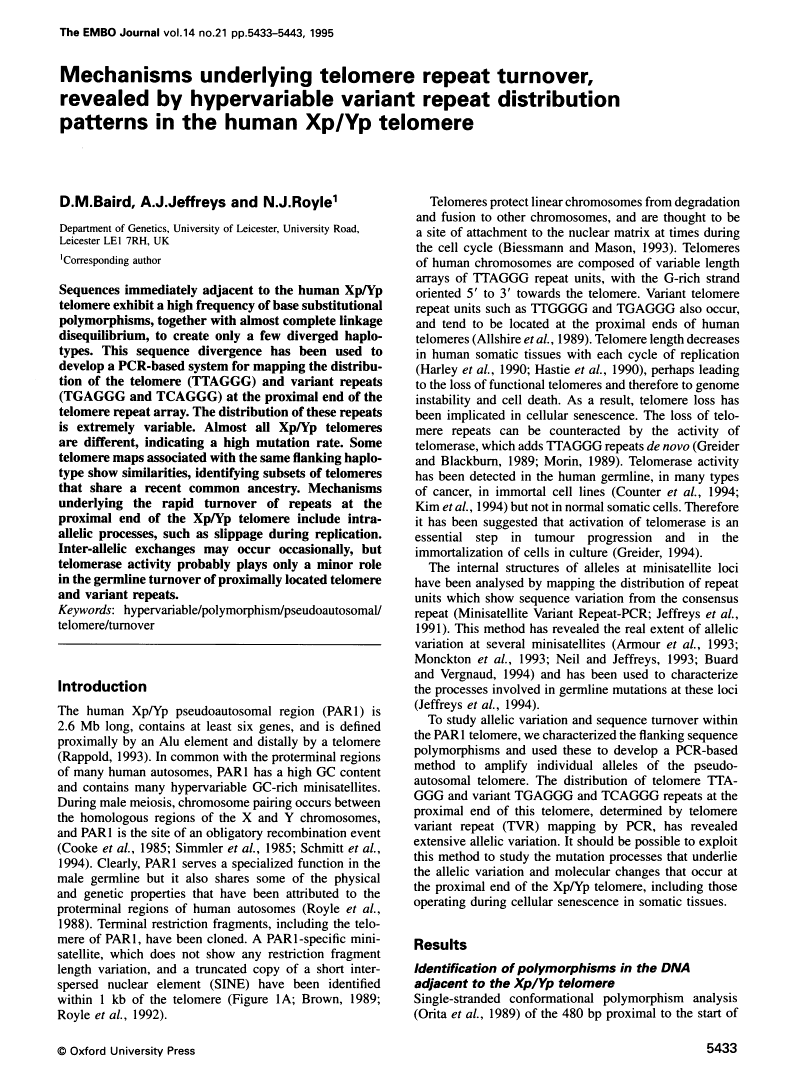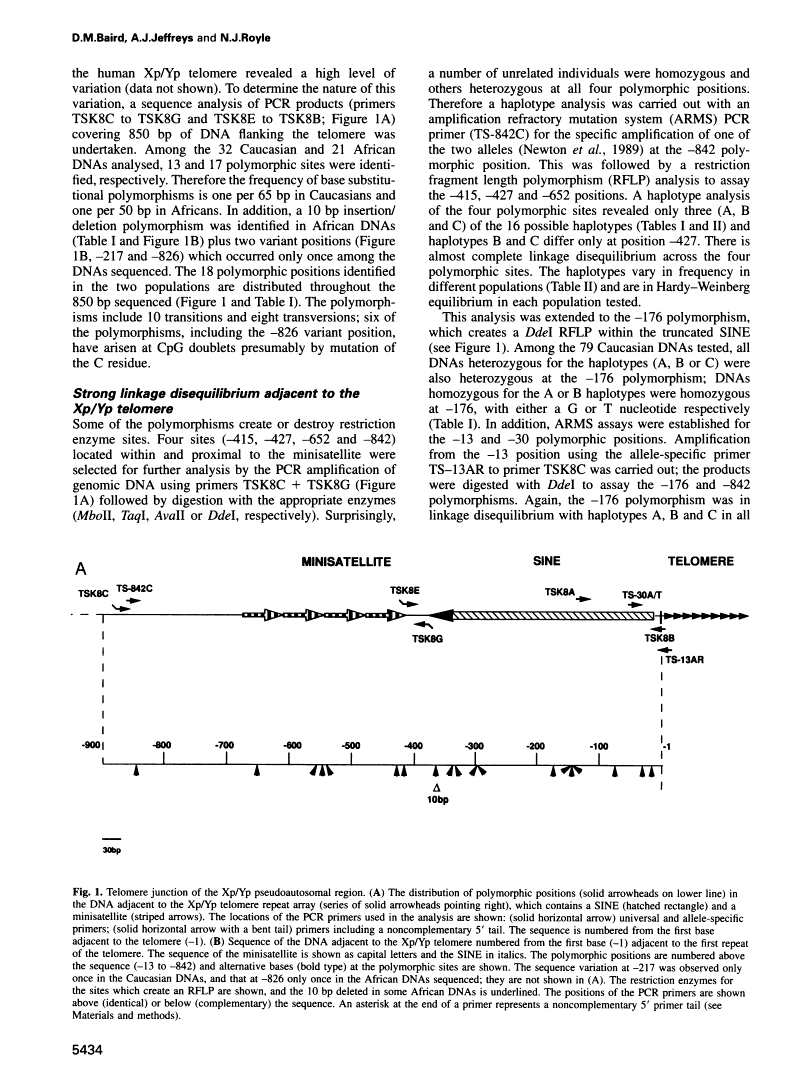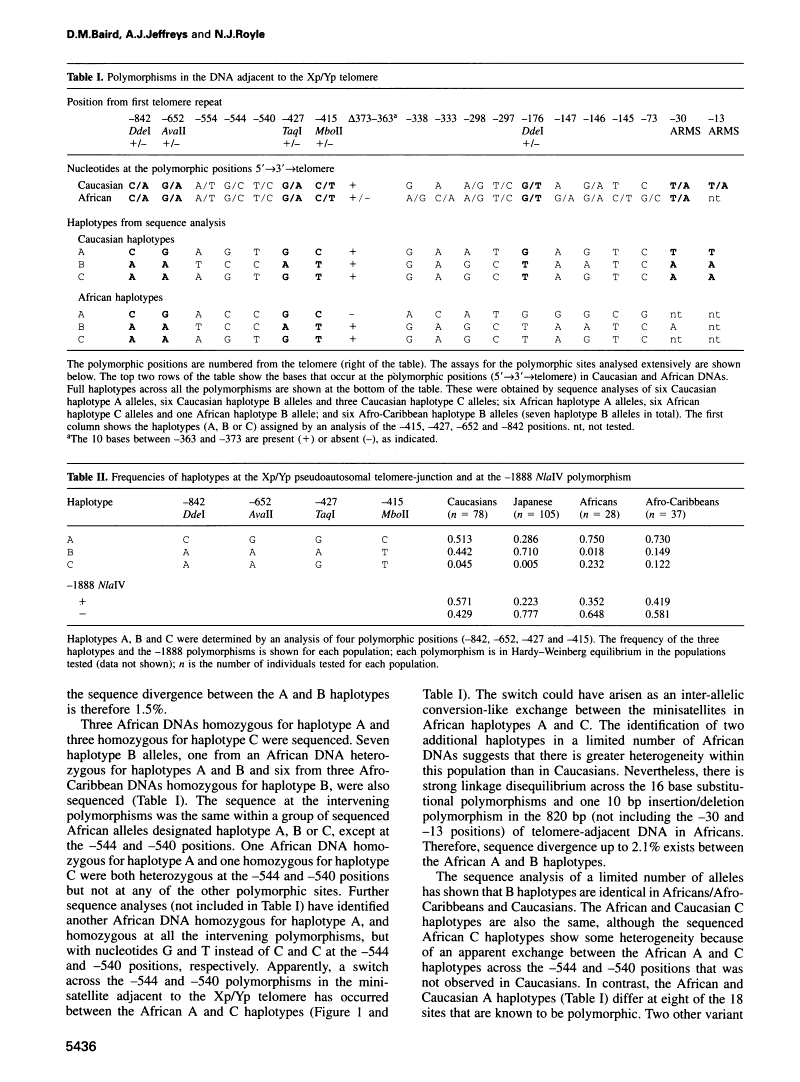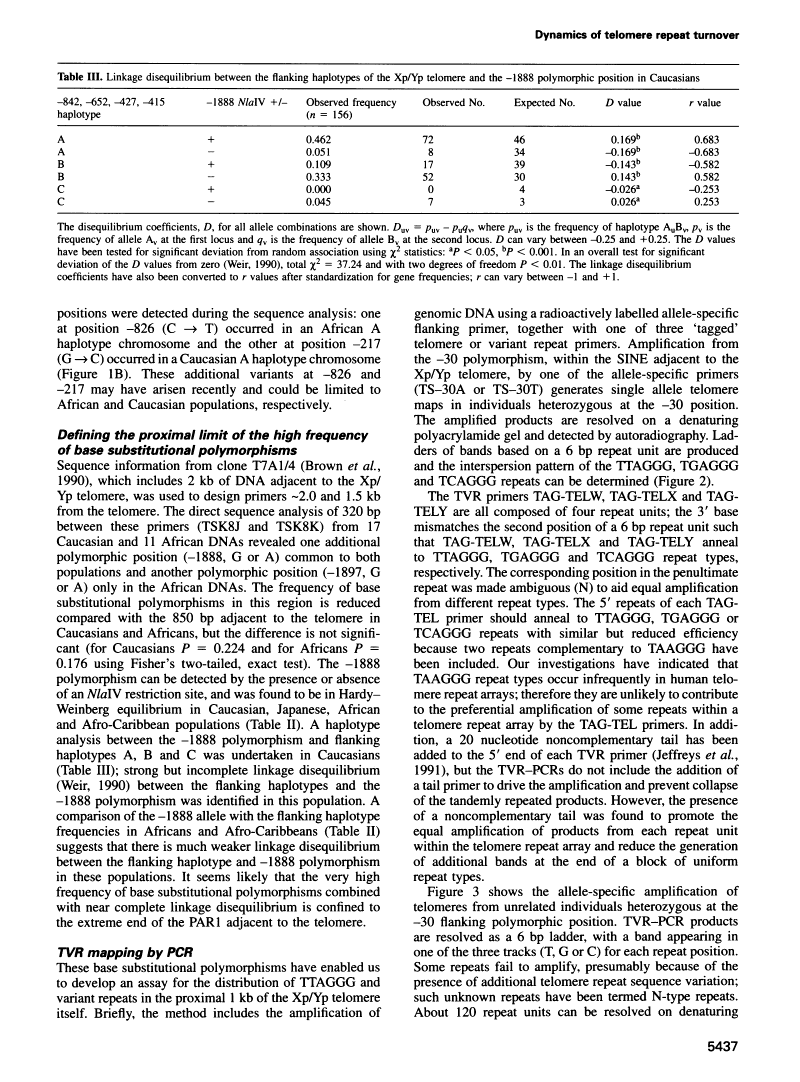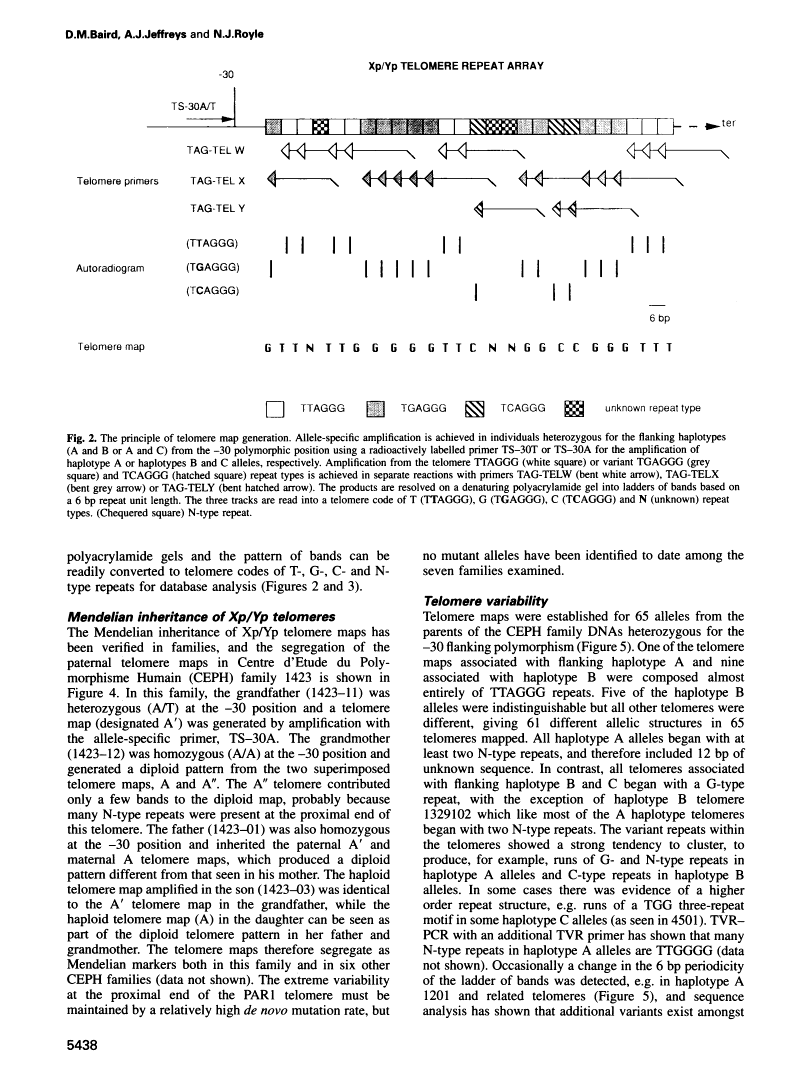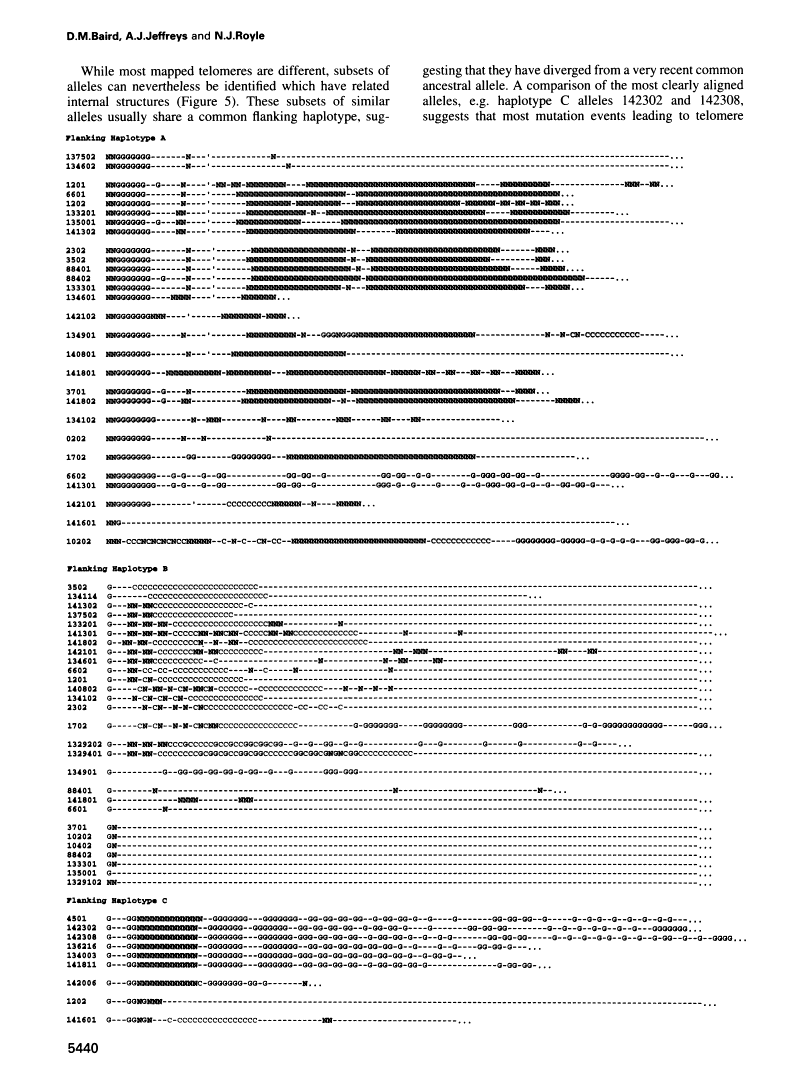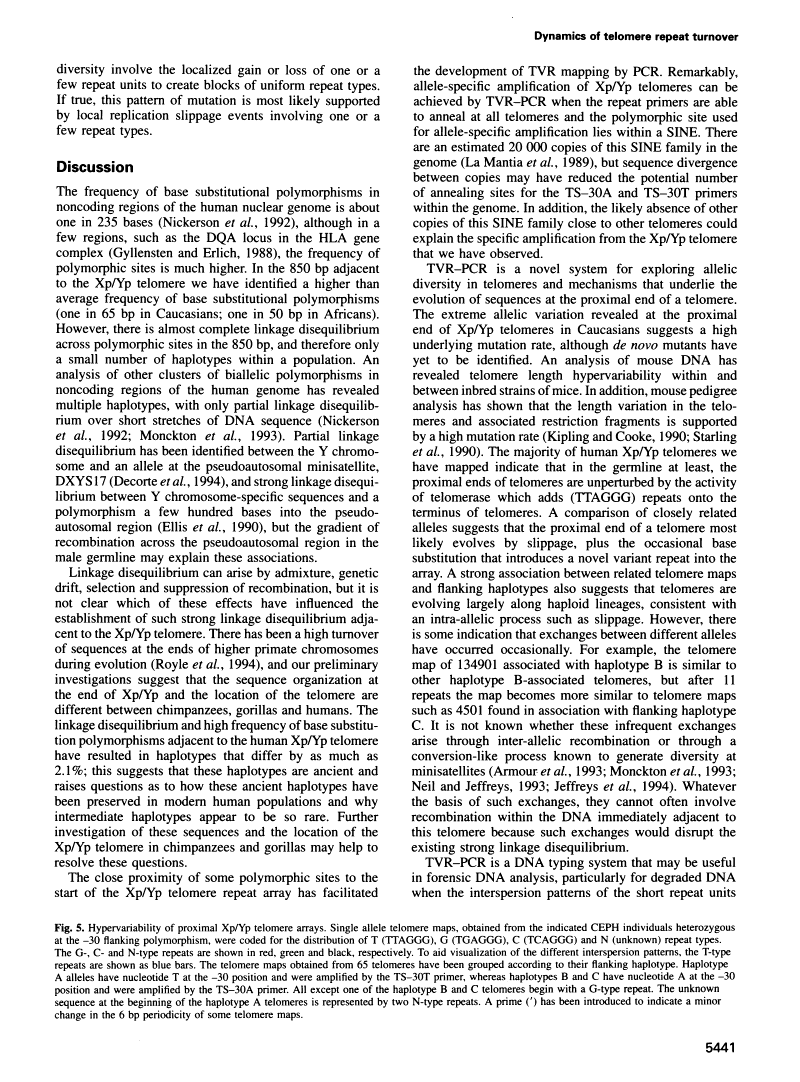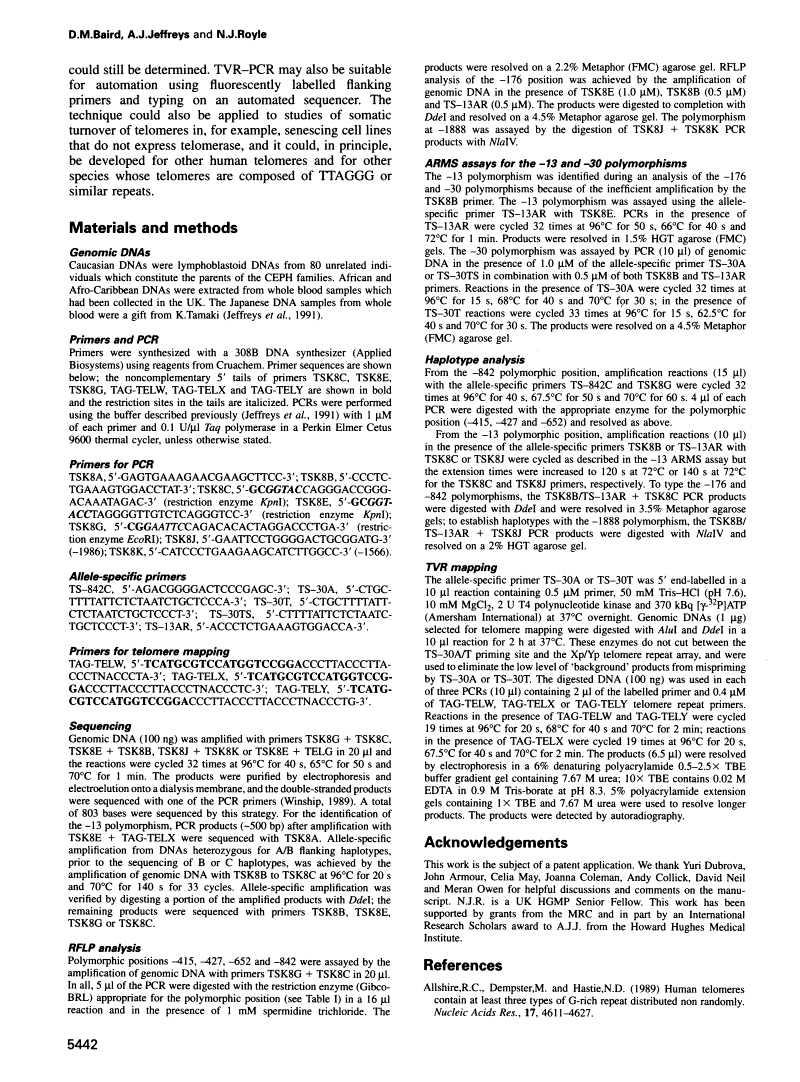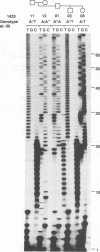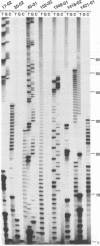Abstract
Free full text

Mechanisms underlying telomere repeat turnover, revealed by hypervariable variant repeat distribution patterns in the human Xp/Yp telomere.
Abstract
Sequences immediately adjacent to the human Xp/Yp telomere exhibit a high frequency of base substitutional polymorphisms, together with almost complete linkage disequilibrium, to create only a few diverged haplotypes. This sequence divergence has been used to develop a PCR-based system for mapping the distribution of the telomere (TTAGGG) and variant repeats (TGAGGG and TCAGGG) at the proximal end of the telomere repeat array. The distribution of these repeats is extremely variable. Almost all Xp/Yp telomeres are different, indicating a high mutation rate. Some telomere maps associated with the same flanking haplotype show similarities, identifying subsets of telomeres that share a recent common ancestry. Mechanisms underlying the rapid turnover of repeats at the proximal end of the Xp/Yp telomere include intra-allelic processes, such as slippage during replication. Inter-allelic exchanges may occur occasionally, but telomerase activity probably plays only a minor role in the germline turnover of proximally located telomere and variant repeats.
Full text
Full text is available as a scanned copy of the original print version. Get a printable copy (PDF file) of the complete article (2.4M), or click on a page image below to browse page by page. Links to PubMed are also available for Selected References.
Images in this article
Selected References
These references are in PubMed. This may not be the complete list of references from this article.
- Allshire RC, Dempster M, Hastie ND. Human telomeres contain at least three types of G-rich repeat distributed non-randomly. Nucleic Acids Res. 1989 Jun 26;17(12):4611–4627. [Europe PMC free article] [Abstract] [Google Scholar]
- Armour JA, Harris PC, Jeffreys AJ. Allelic diversity at minisatellite MS205 (D16S309): evidence for polarized variability. Hum Mol Genet. 1993 Aug;2(8):1137–1145. [Abstract] [Google Scholar]
- Biessmann H, Mason JM. Genetics and molecular biology of telomeres. Adv Genet. 1992;30:185–249. [Abstract] [Google Scholar]
- Brown WR. Molecular cloning of human telomeres in yeast. Nature. 1989 Apr 27;338(6218):774–776. [Abstract] [Google Scholar]
- Brown WR, MacKinnon PJ, Villasanté A, Spurr N, Buckle VJ, Dobson MJ. Structure and polymorphism of human telomere-associated DNA. Cell. 1990 Oct 5;63(1):119–132. [Abstract] [Google Scholar]
- Buard J, Vergnaud G. Complex recombination events at the hypermutable minisatellite CEB1 (D2S90). EMBO J. 1994 Jul 1;13(13):3203–3210. [Europe PMC free article] [Abstract] [Google Scholar]
- Cooke HJ, Brown WR, Rappold GA. Hypervariable telomeric sequences from the human sex chromosomes are pseudoautosomal. Nature. 1985 Oct 24;317(6039):687–692. [Abstract] [Google Scholar]
- Counter CM, Hirte HW, Bacchetti S, Harley CB. Telomerase activity in human ovarian carcinoma. Proc Natl Acad Sci U S A. 1994 Apr 12;91(8):2900–2904. [Europe PMC free article] [Abstract] [Google Scholar]
- Decorte R, Wu R, Marynen P, Cassiman JJ. Identification of internal variation in the pseudoautosomal VNTR DXYS17, with nonrandom distribution of the alleles on the X and the Y chromosomes. Am J Hum Genet. 1994 Mar;54(3):506–515. [Europe PMC free article] [Abstract] [Google Scholar]
- Ellis N, Kidd J, Goodfellow PJ, Kidd K, Goodfellow PN. Strong linkage disequilibrium between the XY274 polymorphism and the pseudoautosomal boundary. Am J Hum Genet. 1990 May;46(5):950–955. [Europe PMC free article] [Abstract] [Google Scholar]
- Greider CW. Mammalian telomere dynamics: healing, fragmentation shortening and stabilization. Curr Opin Genet Dev. 1994 Apr;4(2):203–211. [Abstract] [Google Scholar]
- Greider CW, Blackburn EH. A telomeric sequence in the RNA of Tetrahymena telomerase required for telomere repeat synthesis. Nature. 1989 Jan 26;337(6205):331–337. [Abstract] [Google Scholar]
- Gyllensten UB, Erlich HA. Generation of single-stranded DNA by the polymerase chain reaction and its application to direct sequencing of the HLA-DQA locus. Proc Natl Acad Sci U S A. 1988 Oct;85(20):7652–7656. [Europe PMC free article] [Abstract] [Google Scholar]
- Harley CB, Futcher AB, Greider CW. Telomeres shorten during ageing of human fibroblasts. Nature. 1990 May 31;345(6274):458–460. [Abstract] [Google Scholar]
- Hastie ND, Dempster M, Dunlop MG, Thompson AM, Green DK, Allshire RC. Telomere reduction in human colorectal carcinoma and with ageing. Nature. 1990 Aug 30;346(6287):866–868. [Abstract] [Google Scholar]
- Jeffreys AJ, MacLeod A, Tamaki K, Neil DL, Monckton DG. Minisatellite repeat coding as a digital approach to DNA typing. Nature. 1991 Nov 21;354(6350):204–209. [Abstract] [Google Scholar]
- Jeffreys AJ, Tamaki K, MacLeod A, Monckton DG, Neil DL, Armour JA. Complex gene conversion events in germline mutation at human minisatellites. Nat Genet. 1994 Feb;6(2):136–145. [Abstract] [Google Scholar]
- Kim NW, Piatyszek MA, Prowse KR, Harley CB, West MD, Ho PL, Coviello GM, Wright WE, Weinrich SL, Shay JW. Specific association of human telomerase activity with immortal cells and cancer. Science. 1994 Dec 23;266(5193):2011–2015. [Abstract] [Google Scholar]
- Kipling D, Cooke HJ. Hypervariable ultra-long telomeres in mice. Nature. 1990 Sep 27;347(6291):400–402. [Abstract] [Google Scholar]
- La Mantia G, Pengue G, Maglione D, Pannuti A, Pascucci A, Lania L. Identification of new human repetitive sequences: characterization of the corresponding cDNAs and their expression in embryonal carcinoma cells. Nucleic Acids Res. 1989 Aug 11;17(15):5913–5922. [Europe PMC free article] [Abstract] [Google Scholar]
- Monckton DG, Tamaki K, MacLeod A, Neil DL, Jeffreys AJ. Allele-specific MVR-PCR analysis at minisatellite D1S8. Hum Mol Genet. 1993 May;2(5):513–519. [Abstract] [Google Scholar]
- Morin GB. The human telomere terminal transferase enzyme is a ribonucleoprotein that synthesizes TTAGGG repeats. Cell. 1989 Nov 3;59(3):521–529. [Abstract] [Google Scholar]
- Neil DL, Jeffreys AJ. Digital DNA typing at a second hypervariable locus by minisatellite variant repeat mapping. Hum Mol Genet. 1993 Aug;2(8):1129–1135. [Abstract] [Google Scholar]
- Newton CR, Graham A, Heptinstall LE, Powell SJ, Summers C, Kalsheker N, Smith JC, Markham AF. Analysis of any point mutation in DNA. The amplification refractory mutation system (ARMS). Nucleic Acids Res. 1989 Apr 11;17(7):2503–2516. [Europe PMC free article] [Abstract] [Google Scholar]
- Nickerson DA, Whitehurst C, Boysen C, Charmley P, Kaiser R, Hood L. Identification of clusters of biallelic polymorphic sequence-tagged sites (pSTSs) that generate highly informative and automatable markers for genetic linkage mapping. Genomics. 1992 Feb;12(2):377–387. [Abstract] [Google Scholar]
- Orita M, Iwahana H, Kanazawa H, Hayashi K, Sekiya T. Detection of polymorphisms of human DNA by gel electrophoresis as single-strand conformation polymorphisms. Proc Natl Acad Sci U S A. 1989 Apr;86(8):2766–2770. [Europe PMC free article] [Abstract] [Google Scholar]
- Rappold GA. The pseudoautosomal regions of the human sex chromosomes. Hum Genet. 1993 Oct;92(4):315–324. [Abstract] [Google Scholar]
- Royle NJ, Clarkson RE, Wong Z, Jeffreys AJ. Clustering of hypervariable minisatellites in the proterminal regions of human autosomes. Genomics. 1988 Nov;3(4):352–360. [Abstract] [Google Scholar]
- Royle NJ, Baird DM, Jeffreys AJ. A subterminal satellite located adjacent to telomeres in chimpanzees is absent from the human genome. Nat Genet. 1994 Jan;6(1):52–56. [Abstract] [Google Scholar]
- Schmitt K, Lazzeroni LC, Foote S, Vollrath D, Fisher EM, Goradia TM, Lange K, Page DC, Arnheim N. Multipoint linkage map of the human pseudoautosomal region, based on single-sperm typing: do double crossovers occur during male meiosis? Am J Hum Genet. 1994 Sep;55(3):423–430. [Europe PMC free article] [Abstract] [Google Scholar]
- Simmler MC, Rouyer F, Vergnaud G, Nyström-Lahti M, Ngo KY, de la Chapelle A, Weissenbach J. Pseudoautosomal DNA sequences in the pairing region of the human sex chromosomes. Nature. 1985 Oct 24;317(6039):692–697. [Abstract] [Google Scholar]
- Starling JA, Maule J, Hastie ND, Allshire RC. Extensive telomere repeat arrays in mouse are hypervariable. Nucleic Acids Res. 1990 Dec 11;18(23):6881–6888. [Europe PMC free article] [Abstract] [Google Scholar]
- Winship PR. An improved method for directly sequencing PCR amplified material using dimethyl sulphoxide. Nucleic Acids Res. 1989 Feb 11;17(3):1266–1266. [Europe PMC free article] [Abstract] [Google Scholar]
Associated Data
Articles from The EMBO Journal are provided here courtesy of Nature Publishing Group
Full text links
Read article at publisher's site: https://doi.org/10.1002/j.1460-2075.1995.tb00227.x
Read article for free, from open access legal sources, via Unpaywall:
https://europepmc.org/articles/pmc394652?pdf=render
Citations & impact
Impact metrics
Article citations
Atlas of telomeric repeat diversity in Arabidopsis thaliana.
Genome Biol, 25(1):244, 16 Sep 2024
Cited by: 1 article | PMID: 39285474 | PMCID: PMC11406999
The Structure of Simple Satellite Variation in the Human Genome and Its Correlation With Centromere Ancestry.
Genome Biol Evol, 16(8):evae153, 01 Aug 2024
Cited by: 0 articles | PMID: 39018452 | PMCID: PMC11305138
Neotelomeres and telomere-spanning chromosomal arm fusions in cancer genomes revealed by long-read sequencing.
Cell Genom, 4(7):100588, 24 Jun 2024
Cited by: 4 articles | PMID: 38917803 | PMCID: PMC11293586
Characterization of telomere variant repeats using long reads enables allele-specific telomere length estimation.
BMC Bioinformatics, 25(1):194, 17 May 2024
Cited by: 2 articles | PMID: 38755561 | PMCID: PMC11100205
Telomere sequence variability in genotypes from natural plant populations: unusual block-organized double-monomer terminal telomeric arrays.
BMC Genomics, 24(1):572, 26 Sep 2023
Cited by: 1 article | PMID: 37752451 | PMCID: PMC10521516
Go to all (71) article citations
Other citations
Similar Articles
To arrive at the top five similar articles we use a word-weighted algorithm to compare words from the Title and Abstract of each citation.
Sequences from higher primates orthologous to the human Xp/Yp telomere junction region reveal gross rearrangements and high levels of divergence.
Hum Mol Genet, 6(13):2291-2299, 01 Dec 1997
Cited by: 17 articles | PMID: 9361036
The plasticity of human telomeres demonstrated by a hypervariable telomere repeat array that is located on some copies of 16p and 16q.
Hum Mol Genet, 8(9):1637-1646, 01 Sep 1999
Cited by: 36 articles | PMID: 10441326
High levels of sequence polymorphism and linkage disequilibrium at the telomere of 12q: implications for telomere biology and human evolution.
Am J Hum Genet, 66(1):235-250, 01 Jan 2000
Cited by: 50 articles | PMID: 10631154 | PMCID: PMC1288329
Telomeres in evolution and evolution of telomeres.
Chromosome Res, 13(5):469-479, 01 Jan 2005
Cited by: 81 articles | PMID: 16132812
Review
